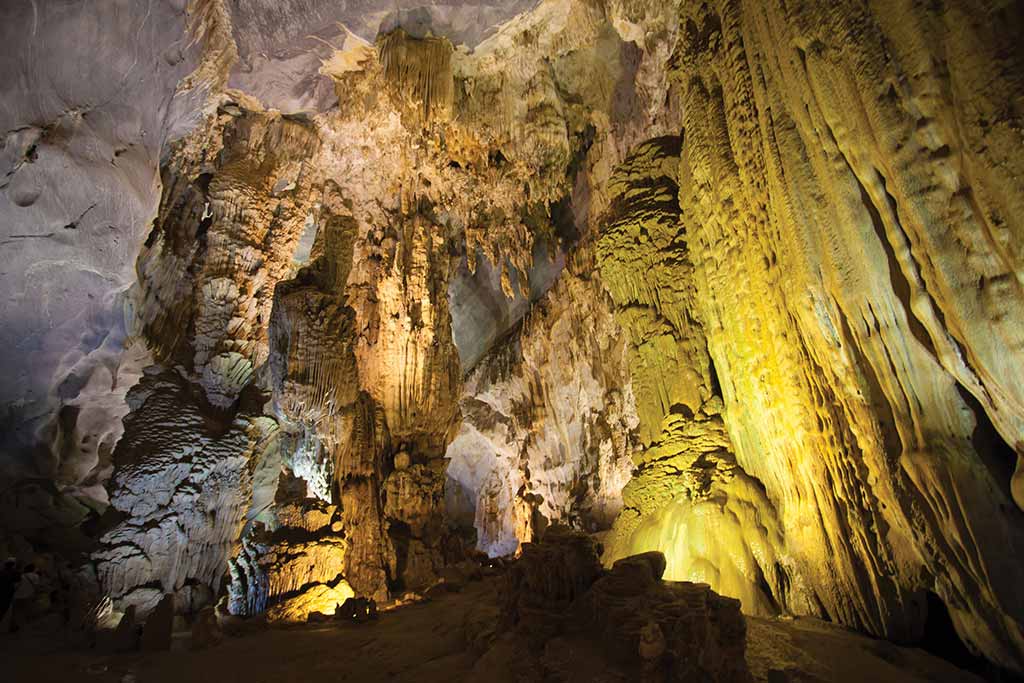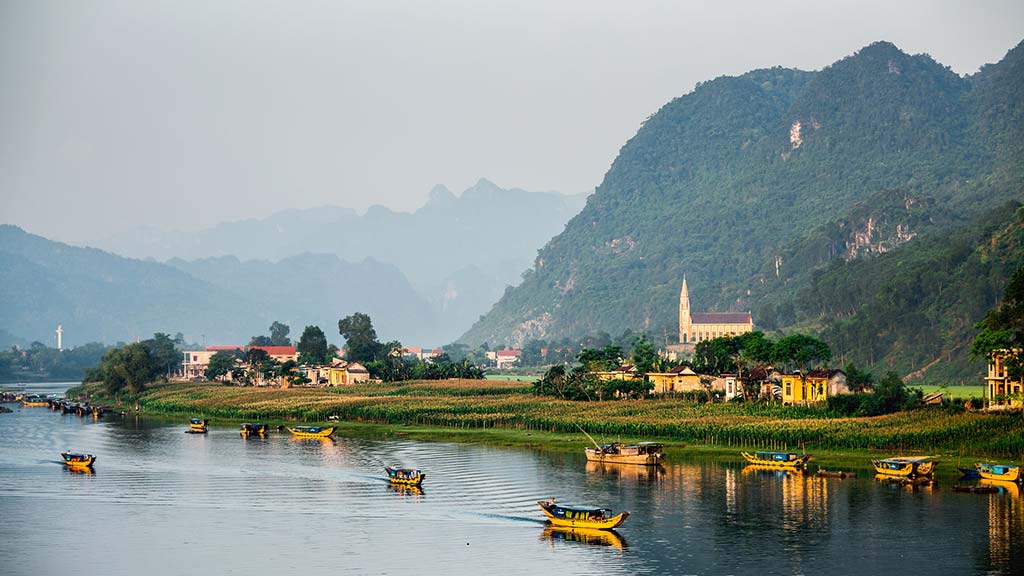A labyrinth of subterranean tunnels and jaw-dropping, otherworldly landscapes, Phong Nha-Ke Bang National Park (TL20, Son Trach village, tel. 05/2367-7323, 7am-5pm daily, entry fees charged per cave) may be off the beaten path for now, but its anonymity is fading fast. Ever since a team of British cavers turned up in 2009 to explore the vast interior of Son Doong, the world’s largest cave, at 5.5 miles long and tall enough to comfortably house a high-rise, tourism to the area has taken off.

Paradise Cave is one of the few sights in the park that can be visited independently. Photo © Dana Filek-Gibson.
Decked out in eerie, alien rock formations and spindly stalactites, these tunnels are estimated at around 3-5 million years old.Just over 130 miles north of Hue, Phong Nha’s major draw is its three sprawling cave systems, Phong Nha, Vom, and Nuoc Mooc, which combine to roughly 90 miles of darkened passageways and have earned the area World Heritage status. Decked out in eerie, alien rock formations and spindly stalactites, these tunnels are estimated at around 3-5 million years old and, according to researchers, may be a mere handful of the caves in existence between here and the Laotian border.It’s possible to visit the park without a tour group, but you’ll be limited to certain caves. For many of the more impressive caves, visitors must be a part of a tour group. Phong Nha offers cave tours only through certified companies and limits the number of annual visitors to Son Doong, which can be explored for a cool USD$3,000 a head.
Day trips from Hue are cheap, though these are hardly worth the effort, as the long drive to and from the park eats up most of your time. Staying closer to the park offers you the chance to experience Phong Nha in greater depth. On longer excursions, you may find yourself wading into a subterranean river, rappelling down a rock face, or camping out in a cave. While these adventures are a little more expensive than most, the quality of the park’s conservation efforts and the expertise of local caving companies more than justify the price tag.
Visit Phong Nha between February and September, when the weather allows for full access to its underground attractions. Rainy season, particularly the months of October and November, can be restrictive, as rivers rise and the area’s rainfall renders some of the more adventurous options unavailable. Phong Nha is a budding tourism destination, so don’t expect to find five-star hotels or fine dining. Travel to and from the area can require more time and money due to its remoteness, but those who do so will find this destination one of the most memorable in Vietnam.

Boats along the river in the National Park of Phong Nha Ke Bang. Photo © mihtiander/123rf.
You could fit a jumbo jet or a city block inside Son Doong and still have room left over. This massive grotto stretches about three miles into the earth, with a range of landscapes you’d seldom imagine inside a darkened cave. A river roars through Son Doong, tumbling over cliffs and around corners. Clouds pass through its many chambers each day. Thanks to a pair of large skylights, Son Doong is also home to a jungle, complete with monkeys, snakes, flying foxes, and birds, not to mention a few new species discovered within its massive boundaries.
The discovery of this jaw-dropping subterranean world belongs to Ho Khanh, a local farmer who happened upon the entrance one day in 1991. At the time, the find was of little consequence, and so the man carried on but filed its location away in the back of his mind. Not until 2009 would Howard Limbert and the British Cave Research Association enlist Ho Khanh’s assistance in tracking down the cavern once more. The team of cavers was able to measure the size and length of Son Doong, and the results turned out to be far greater than Malaysia’s Deer Cave, the previous record holder. There is still plenty to be learned about Son Doong and the surrounding area—many believe there are even bigger underground chambers nearby.
An expert team of caving professionals at Oxalis (Son Trach village, tel. 05/2367-7678) have begun running six-day excursions into Son Doong at USD$3,000 a head. The outrageous cost makes at least some sense when you consider the number of porters required, not to mention the fact that you have to rappel down a cliff and trek through the jungle just to reach Son Doong’s entrance. In order to preserve the wildlife and landscapes of the cave, only 220 permits were issued in 2014. Oxalis is the only outfit with permission to enter the cave.
Excerpted from the First Edition of Moon Vietnam.